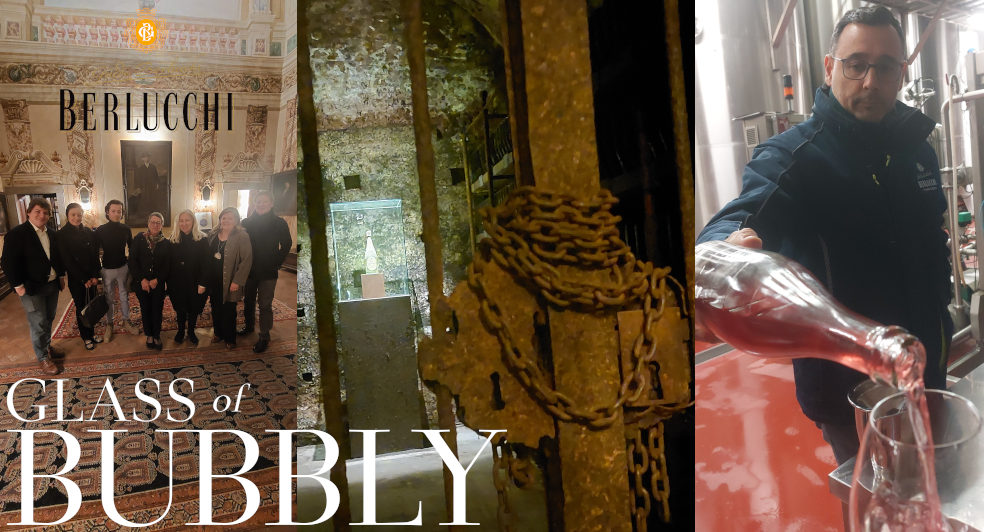Berlucchi Guido
6th June 2024

Following my recent visit to Franciacorta, I discovered one of the biggest and most influential wineries in the region, Berlucchi Guido.
Berlucchi Guido produces 3.5 million bottles on 500 hectares a year, they own 140 hectares and the rest are rented, with 60% of the rented vineyards growing organic grapes. 15-20% of the grape juice gathered from any specific year is moved into their reserve tanks. Their Cuvée Imperial line contains 6 labels and is mainly produced for the Italian supermarket scene.
It was interesting to note that they now keep 1,500 bottles of every vintage so they can start building a mighty library of wines, starting their oenothèque range from the 2002 vintage.
While touring their winery we met their winemaker, who was excited to share with us some of their younger wines, still containing the yeast, and yet to hit the market. Here are my tasting notes on them.
Berlucchi Guido – TN: “Apple juice, freshly squeezed with notes of yeasty characters. Flavours are crisp, acidic, sour green apples, very life like, and unique. Still contained the yeast.”
Berlucchi Guido – Chardonnay TN: “More real ripe green apple juice, slightly different, with a bigger mix of faint other orchard fruits. Creamy sour citrus, green apples, almost apple sherbert flavour, with notes of honeydew melon and mouth watering with acidity. Still contained yeast.”
Berlucchi Guido – 100% Pinot Noir TN: “Creamy milky strawberry and red berries, strawberry yoghurt, light feta cheese, more strawberry. Ripe and slightly unripe strawberry, more bitter notes.”
Berlucchi Guido – Both the Chardonnay and Pinot Noir together in one glass: “Strawberry, apple juice and honeydew melon. Softer expression, nicer combination, smooth apple juices, juicy melons.”
Venturing up into their grand tasting room, we got to taste 8 of their Sparkling Wines, including their famous 61 labels and the oldest vintage of our trip, a 2008 vintage.
61 Satèn: “Very fresh in the palate, fizzy, millions of bubbles popping on the tongue, sweet citrus, delicate lemon sherbet, mango skin on the aroma.”
61 Extra Brut: “Not so vibrant as the first, still with very similar characters, but with a delicate brioche and bakery aroma. Candy, melon candy, tropical candy.”
61 Rosé: “Raspberries on the aroma. Delicious pink strawberries and raspberries on the palate with notes of creamy squirty cream and vanilla ice cream sensation, with pink Pomegranate.”
61 Nature Blanc de Blanc 2016: “Fruity notes, a touch of yeast, bruised green apples. Rich, golden fruits, very bold in the glass, a vibrant citrus/zesty lemon fizzy on the palate.”
61 Brut Nature 2016: “Shortcake, subtle brioche, freshly baked, biscuits.”
61 Nature Rosé 2016: “Strawberry shortcake, ripe freshly sliced strawberries on shortbread. Vibrant strawberries, raspberries, very well baked shortbread.”
Palazzo Laura 2011: “Golden aged finesse, subtle yellow stone fruits, with some ageing to them, mature lemon citrus, malolactic.”
Franciacorta Riserva Cuvee 2008: “A very subtle reminder of Ratafia, one of the light yellow stone fruit driven examples, golden syrupy, apricots both dried and fresh, wild yellow and white floral. Concentrated golden and yellow stone fruits, strong in character, acidic and lemon skins.”
When returning home to England, I was shortly after able to taste a bottle of Berlucchi 61 Brut 2017 Vintage, discovering: “A finer aged complexion, enhancing a richer baked bread, okay, pastry display, with glorious golden fruits and lemon zest, touch if minerals and chalk in length, you also get a sweet taste of lemon tart, the wine in the bottle has aged wonderfully, although I still taste how young it is, I believe Franciacorta has a great potential for further ageing.”
![]()
Oliver Walkey
Champagne and Sparkling Wine Writer, Focused on Bringing the Exciting and Fascinating World of Bubbly to You.
